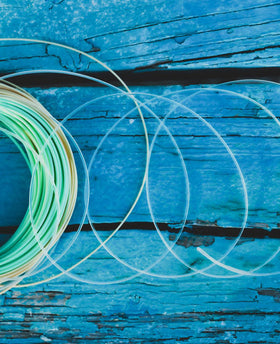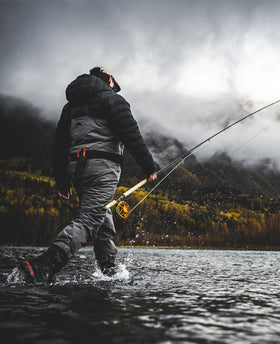
Alpine Lake Fishing
Typically, alpine lakes are filled with brook trout or native cutthroat, but there are always opportunities for different species such as tiger trout, grayling, and the elusive golden. Due to the short season of open water, these fish are eating just about everything they can find to prepare themselves for the quickly approaching winter season. Dry flies are the favorite for alpine fishing, but there are a variety of techniques that also work. In this article we are going to be covering the favorite techniques and gear used to fish alpine lakes.

Dry Fly:
This is a pretty self explanatory approach. Find a cruising fish, cast your dry fly a few feet ahead of it and hope they like the presentation. Another way of fishing the dry fly is casting it in the general area where fish have been rising further out in the lake and waiting for them to see your fly. A few of our favorite dry flies here at Golden Fly Shop are the Hi-Vis Micro Chubby, the Humpy, Elk Hair Caddis, Parachute Adams, and No Sink Ant. Sizing down certainly helps at times in alpine fisheries. Midges and tiny flying ants make up a lot of their diet, so if you continuously get refusals on “bigger” presentations, sizing down to a Booty Midge is a great choice. If you continue to get refusals, it’s never a bad idea to throw on a Pheasant Tail or Zebra Midge below your dry to convert those picky eaters.
Nymphing:
What?? Nymphing on an alpine lake?? Yes, sometimes you have to nymph on an alpine lake and given certain conditions it may be the only presentation that will catch you a fish. At lower elevations, water temperatures in shallower sections of the lake will push trout out to deeper water near rocky points, drop offs, or inflow/outflow areas. Trout will also move out to these areas at higher elevations, but the reasoning for this can vary. When fish transition to these deeper areas, a dry fly presentation or a dry/dropper often will not convert an eat as the fish are sitting feet below the surface and don’t want to come to the top to eat. Nymphing on a lake is pretty straightforward, only a few flies are required to get them to eat. Our favorites are the Jigged Mini Leech, Chironomid Bomber, Ice Cream Cone, and the all time classic Hare’s Ear. The most important aspect of your nymphing presentation on an alpine lake is finding the right depth. This can be anywhere from 3 feet below to surface, downwards to 15 feet. Once you find the right depth it’s game on as trout spend the majority of their time subsurface feeding.
Streamer:
Streamer fishing at an alpine lake can be the ticket from turning an okay day to an outrageous one. As mentioned previously, these trout have a limited feeding season and because of this they may be more willing to eat bigger, more caloric forage while they can. When it comes to streamers, think leeches, juvenile trout, suckers, or other baitfish species. The presentation is simple, cast your fly out and strip it in. There’s often some variability to this as some stripping cadences will be preferred over others, so vary your retrieval until you find the right one. Our favorite alpine lake streamers are the Jigged Mini Leech, Meat Whistle, Near Nuff Sculpin, and the Jigged Rubber Leg Bugger.
The Rods:
Some may refer to me as a gear nerd, but I like having the right rod for the right scenario. For an alpine lake where I know the fish aren’t going to be of great size, I like a 7 or 7.5’ 3wt for my dry fly setup. This makes the fight a lot more fun for these smaller fish, and they typically pack down much better because of their shorter length. In lakes where fish average over 12”, I opt for a 9’ 5wt rod. Having the extra backbone can handle bigger fish and will give you the ability to cast further distances. When I know I’m heading to a lake where I’ll be nymphing, I always bring my trusty 10’ 6wt. It may sound like overkill for an alpine lake, but this rod allows me to roll cast heavy nymph rigs at greater distances and handle bigger fish. (Pro tip: Lakes where you need to spend more time nymphing are typically where large fish exist. So if you’re looking for a trophy cutthroat or brook trout, bet on nymphing.) For streamer fishing, I also like the 10’ 6wt because it allows me to reach further distances on a lake and cover more water. Obviously having three different setups for fishing the alpine isn’t ideal, but if you have the means you should. All three rods are daily users in our state, the 3wt is a great creek stick, the 5wt is an all purpose rod for all of our bodies of water, and the 10’ 6wt is the ultimate nymphing stick on rivers and all around stillwater rod. If you can’t have all three rods in your arsenal, no problem! As we all know, the 9’ 5wt is the ultimate all around trout stick and will cover all of your alpine lake fishing needs.

Don’t forget to bring plenty of water, extra food, sunscreen, a raincoat, and an extra jacket. Weather changes quickly in the high country, and being ill prepared can be deadly. Enjoy your summer of alpine lake fishing and we hope this article serves you well.
If you have any questions about alpine lake fishing, feel free to call the shop at
303-330-1292, or email Xavier at xavier@goldenflyshop.com




Leave a comment